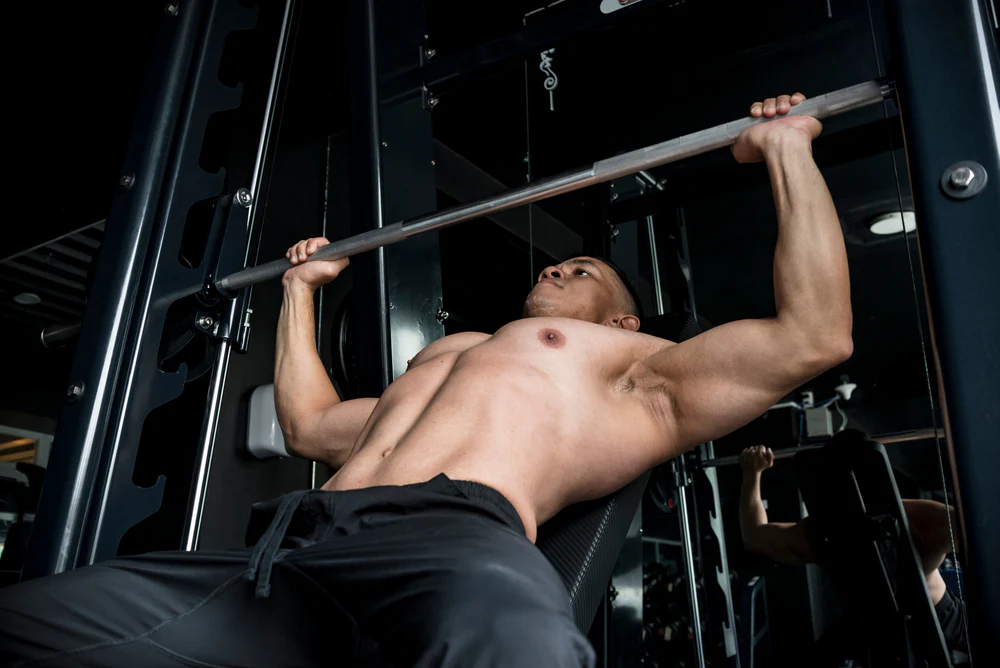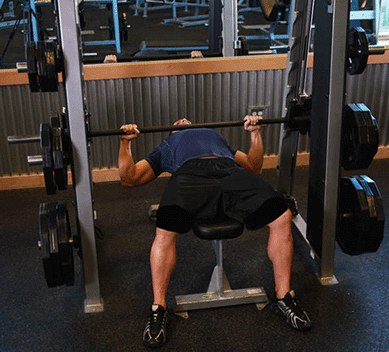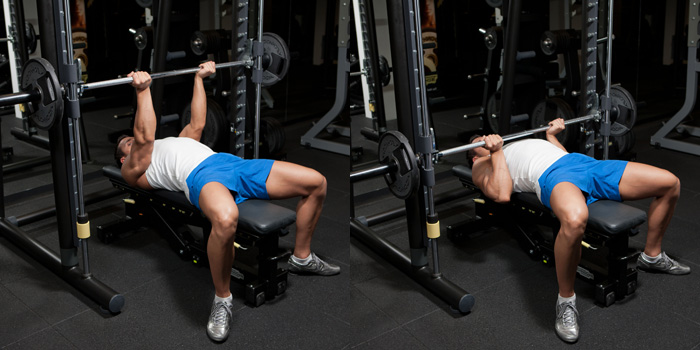The Smith machine bench press is a staple exercise in any gym, offering a safe and effective way to target the chest primarily while shoulders and triceps secondarily. Whether you’re a beginner or an experienced lifter, mastering proper form and technique is essential for maximizing results and preventing injury. In this detailed guide, we’ll explain to you about everything you need to know about performing the Smith machine bench press, including its benefits, variations, common mistakes, and how to incorporate it into your workout routine. Without wasting anymore time, let’s take a deep dive into this.

Understanding the Smith Machine Bench Press
The Smith machine bench press is a variation of the traditional bench press, where you use a Smith machine instead of a free-weight barbell. The Smith machine consists of a barbell attached to vertical rails, allowing for controlled movement along a fixed path. This guided motion provides stability and support, making it an ideal option for beginners or individuals with limited experience in weightlifting. You can do several other compound exercises for other muscle groups with smith machine such as smith machine shoulder press, smith machine squat etc.
Benefits of the Smith Machine Bench Press
Safety
The Smith machine provides a built-in safety mechanism, with the barbell locked into place along a fixed path. This reduces the risk of injury by preventing the barbell from tipping or rolling during the exercise.
Stability
The guided movement of the Smith machine bench press helps to stabilize the weight, allowing you to focus on proper form and technique without the need for a spotter.
Muscle Isolation
The Smith machine bench press targets the chest muscles greatly along with shoulders, and triceps muscles while minimizing involvement of other muscle groups, such as the core and lower back. This allows for more targeted muscle activation and development.
Progressive Overload
The Smith machine allows for easy adjustment of resistance levels, making it suitable for progressive overload training and strength progression over time.
Versatility
The Smith machine bench press can be performed with various grip widths, hand positions and with different angles of bench allowing for versatility in training and targeting different areas of the chest, triceps and shoulders. For example, you can adjust the angles of the bench to perform incline or decline smith machine bench press for upper and lower chest respectively. Or you can use close grip for emphasizing the triceps more.
Step-by-step Guide to Perform the Smith Machine Bench Press
Setup
Position an adjustable bench in the center of the Smith machine, with the backrest staying flat at 0° for flat bench press. Adjust the height of the barbell so that it is within easy reach when lying on the bench. If you want to perform incline bench press then adjust the backrest at 30 to 45 degrees or 15 to 30 degrees at declined position for decline bench press.
Grip
Grasp the barbell with an overhand grip, slightly wider than shoulder-width apart. Your wrists should be straight, and your elbows should be bent at approximately 90 degrees.
Positioning
Lie down on the bench with your back flat against the backrest and your feet firmly planted on the floor. Position yourself so that the barbell is directly above your chest, with your eyes aligned underneath the bar.
Execution
Push the barbell upwards by extending your arms fully, pushing the weight towards the ceiling in a controlled manner. Keep your shoulders down and back, avoiding shrugging or rounding of the shoulders.

Breathing
Inhale as you lower the barbell towards your chest, and exhale as you press the barbell upwards. Focus on maintaining a steady and controlled breathing pattern throughout the exercise.
Range of Motion
Lower the barbell until it gently touches your chest, allowing for a full range of motion while maintaining tension in the chest muscles. Avoid bouncing the barbell off your chest or locking out your elbows at the top of the movement.
Repetition
Complete the desired number of repetitions with proper form and technique. Aim for 8-12 repetitions per set, adjusting the weight as needed to challenge your muscles while maintaining good form.
Cooldown
Once you’ve completed your sets, carefully rack the barbell and take a moment to stretch your chest and upper body to promote recovery and flexibility.
Incorporating the Smith Machine Bench Press into Your Routine
The best way to incorporate this outstanding chest exercise is to perform it in your chest day or push day (if you are following push pull legs) as a starting exercise for building a big, strong and defined chest.
Perform the Smith machine bench press 1-2 times per week, with 3-4 sets of 8-12 repetitions per session. Start with a light weight to warm up the muscles and gradually increase the weight as you become more comfortable with the movement.
In addition to this chest movement, include a variety of other chest exercises such as incline dumbbell press, cable chest press, and cable fly to target different areas of the chest and ensure balanced muscle development throughout your whole chest.
Common Mistakes to Avoid
Rounding the Lower Back
Avoid arching or rounding your lower back during the Smith machine bench press. Maintain a neutral spine to prevent strain on the lower back and maintain proper alignment throughout the movement.
Using Excessive Weight
Choose a weight that allows you to perform the exercise with proper form and technique. Using excessively heavy weights can compromise your form and increase the risk of injury on your shoulders.
Locking Out the Elbows
Avoid locking out your elbows at the top of the movement, as this can strain the elbow joints and reduce muscle tension in the chest. Keep a slight bend in the elbows to maintain tension in the muscles throughout the exercise.
Bouncing the Barbell
Avoid bouncing the barbell off your chest while lowering it at the bottom of the movement. This reduces muscle activation and increases the risk of injury. Lower the barbell under control until it gently touches your chest, then press it upwards with controlled force.
Not Using a Full Range of Motion
Ensure that you lower the barbell until it gently touches your chest, allowing for a full stretch in the chest muscles. Avoid cutting the range of motion short, as this limits muscle growth and development.
Variations of the Smith Machine Bench Press
Close Grip Bench Press
Place your hands closer together on the barbell, with your thumbs touching or slightly overlapping. This variation targets the triceps muscles to a greater extent and can also help to improve lockout strength.
Reverse Grip Bench Press
Grasp the barbell with an underhand grip (palms facing towards you) instead of an overhand grip. This variation targets the upper chest and front deltoids while placing less stress on the shoulders and wrists.

Incline Smith Machine Bench Press
Adjust the bench to a steeper incline angle (around 30 to 45 degrees) to target the upper chest muscles to a greater extent. This variation helps to build size and definition in the upper chest area.

Decline Smith Machine Bench Press
Contrary to incline variation, here you have to adjust the backrest of the bench around 15 to 30 degrees in declined position and then perform the bench press. Decline variation of this exercise will greatly emphasize your lower chest area and can be great exercise to burn the fats in those areas.
Conclusion
The Smith machine bench press is a versatile and effective exercise for targeting the chest, shoulders, and triceps muscles. By mastering proper form and technique, avoiding common mistakes, and incorporating variations into your routine, you can maximize the benefits of this exercise and achieve your fitness goals safely and effectively. Whether you’re a beginner or an experienced lifter, the Smith machine bench press offers an amazing addition to your chest training arsenal for building size, strength, and definition in your chest muscles. Hopefully, you found this article helpful enough. If you really did then let us know your unfiltered thoughts in the comment section down below. Thanks for visiting and appreciating our work.
